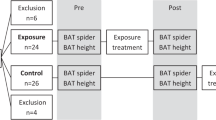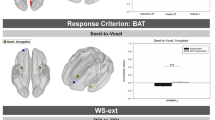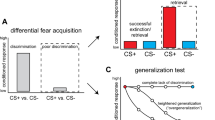Abstract
Exposure therapy is highly effective in treating excessive fear related to specific objects and/or situations. However, patients with anxiety disorders often display a generalization of fear responses toward conceptually and perceptually related stimuli and situations. It is unclear whether the beneficial effects of exposure on fear reduction toward treated fear stimuli can extend to untreated fear stimuli. Here, we investigated whether basic principles of extinction generalization apply to exposure. Spider-phobic participants were randomly assigned to either two sessions of exposure treatment (n=23) with spiders or no-treatment (n=24). Prior to and after treatment, behavioral approach tests (BATs) were conducted to examine avoidance, fear and disgust responses toward the treated phobic stimulus (spider as the extinction stimulus). Likewise, BATs with the untreated fear stimulus (cockroach) were conducted to dissect the generalization of treatment effects. Treatment was highly effective in increasing approach behavior toward both treated and untreated fear stimuli. Generalization of treatment effects were evident on the behavioral (approach distance during the BAT), subjective (fear levels during the BAT) and psychophysiological level (heart rate during the BAT). However, a stronger decline in disgust was only evident for the treated fear stimulus. Notably, the herein attained generalization effects were not context-dependent. Hence, exposure therapy for spider phobia was effective in reducing fear of untreated stimuli which share common fear-evoking characteristics with spiders but were never presented during the respective exposure treatment. These findings provide clinical evidence for extinction generalization across different fear-evoking stimuli mediated via exposure.
Similar content being viewed by others
Log in or create a free account to read this content
Gain free access to this article, as well as selected content from this journal and more on nature.com
or
References
Arntz A, Lavy E, van den Berg G, van Rijsoort S (1993). Negative beliefs of spider phobics: a psychometric evaluation of the spider phobia beliefs questionnaire. Adv Behav Res Ther 15: 257–277.
Baeyens F, Diaz E, Ruiz G (2005). Resistance to extinction of human evaluative conditioning using a between-subjects design. Cogn Emot 19: 245–268.
Barlow DH (1988) Anxiety and its Disorders: The Nature and Treatment of Anxiety and Panic. Guilford Press: New York.
Botella C, Breton-Lopez J, Quero S, Banos R, Garcia-Palacios A (2010). Treating cockroach phobia with augmented reality. Behav Ther 41: 401–413.
Bouton ME (2002). Context, ambiguity, and unlearning: sources of relapse after behavioral extinction. Biol Psychiatry 52: 976–986.
Butler AC, Chapman JE, Forman EM, Beck AT (2006). The empirical status of cognitive-behavioral therapy: A review of meta-analyses. Clin Psychol Rev 26: 17–31.
Byrne SP, Rapee RM, Richardson R, Malhi GS, Jones M, Hudson JL (2015). D-cycloserine enhances generalization of fear extinction in children. Depress Anxiety 32: 408–414.
Craske MG, Kircanski K, Zelikowsky M, Mystkowski J, Chowdhury N, Baker A (2008). Optimizing inhibitory learning during exposure therapy. Behav Res Ther 46: 5–27.
Craske MG, Treanor M, Conway CC, Zbozinek T, Vervliet B (2014). Maximizing exposure therapy: an inhibitory learning approach. Behav Res Ther 58: 10–23.
Davey GCL (1991). Characteristics of individuals with fear of spiders. Anxiety Res 4: 299–314.
de Jong PJ, Muris P (2002). Spider phobia: interaction of disgust and perceived likelihood of involuntary physical contact. J Anxiety Disord 16: 51–65.
Dunsmoor JE, Murphy GL (2014). Stimulus typicality determines how broadly fear is generalized. Psychol Sci 25: 1816–1821.
Dunsmoor JE, Murphy GL (2015). Categories, concepts, and conditioning: how humans generalize fear. Trends Cogn Sci 19: 73–77.
Dunsmoor JE, Paz R (2015). Fear generalization and anxiety: behavioral and neural mechanisms. Biol Psychiatry 78: 336–343.
Dymond S, Dunsmoor JE, Vervliet B, Roche B, Hermans D (2015). Fear generalization in humans: systematic review and implications for anxiety disorder research. Behav Ther 46: 561–582.
Hamm A (2006) Spezifische Phobien. Hogrefe Göttingen.
Hofmann SG, Smits JAJ (2008). Cognitive-behavioral therapy for adult anxiety disorders: a meta-analysis of randomized placebo-controlled trials. J Clin Psychiatry 69: 621–632.
Hofmann W, De Houwer J, Perugini M, Baeyens F, Crombez G (2010). Evaluative conditioning in humans: a meta-analysis. Psychol Bull 136: 390–421.
Lovibond SH, Lovibond PF (1995) Manual for the Depression Anxiety Stress Scales 2nd edn. Psychology Foundation: Sydney, Australia.
Ludvik D, Boschen MJ, Neumann DL (2015). Effective behavioural strategies for reducing disgust in contamination-related OCD: A review. Clin Psychol Rev 42: 116–129.
Margraf J (1994) Mini-DIPS. Diagnostisches Kurzinterview bei psychischen Störungen. Springer: Heidelberg.
Matchett G, Davey GC (1991). A test of a disease-avoidance model of animal phobias. Behav Res Ther 29: 91–94.
Mineka S, Mystkowski JL, Hladek D, Rodriguez BI (1999). The effects of changing contexts on return of fear following exposure therapy for spider fear. J Consult Clin Psychol 67: 599–604.
Mystkowski JL, Craske MG, Echiverri AM (2002). Treatment context and return of fear in spider phobia. Behav Ther 33: 399–416.
Norton PJ, Price EC (2007). A meta-analytic review of adult cognitive-behavioral treatment outcome across the anxiety disorders. J Nervous Ment Dis 195: 521–531.
Olatunji BO, McKay D (2007a). Disgust and psychiatric illness: have we remembered? Br J Psychiatry 190: 457–459.
Olatunji BO, Smits JAJ, Connolly K, Willems J, Lohr JM (2007b). Examination of the decline in fear and disgust during exposure to threat-relevant stimuli in blood-injection-injury phobia. J Anxiety Disord 21: 445–455.
Öst LG (1997) Rapid treatment of specific phobias. In: Davey GCL (ed). Phobias: A handbook of Theory, Research and Treatment. Wiley: New York. pp 227–246.
Pace-Schott EF, Verga PW, Bennett TS, Spencer RMC (2012). Sleep promotes consolidation and generalization of extinction learning in simulated exposure therapy for spider fear. J Psychiatr Res 46: 1036–1044.
Pössel P, Hautzinger M (2003). Dysfunktionale Überzeugungen bei Spinnenangst. Zeitschrift Klin Psychol Psychother 32: 24–30.
Rinck M, Bundschuh S, Engler S, Muller A, Wissmann J, Ellwart T et al (2002). Reliability and validity of German versions of three instruments measuring fear of spiders. Diagnostica 48: 141–149.
Rodriguez BI, Craske MG, Mineka S, Hladek D (1999). Context-specificity of relapse: effects of therapist and environmental context on return of fear. Behav Res Ther 37: 845–862.
Rowe MK, Craske MG (1998a). Effects of an expanding-spaced vs massed exposure schedule on fear reduction and return of fear. Behav Res Ther 36: 701–717.
Rowe MK, Craske MG (1998b). Effects of varied-stimulus exposure training on fear reduction and return of fear. Behav Res Ther 36: 719–734.
Ruhmland M, Margraf J (2001a). Effektivität psychologischer Therapien von generalisierter Angststörung und sozialer Phobie: Meta-Analysen auf Störungsebene. Verhaltenstherapie 11: 27–40.
Ruhmland M, Margraf J (2001a). Effektivität psychologischer Therapien von Panik und Agoraphobie: Meta-Analysen auf Störungsebene. Verhaltenstherapie 11: 41–53.
Ruhmland M, Margraf J (2001c). Effektivität psychologischer Therapien von spezifischer Phobie und Zwangsstörung: Meta-Analysen auf Störungsebene. Verhaltenstherapie 11: 14–26.
Schienle A, Walter B, Stark R, Vaitl D (2002). Ein Fragebogen zur Erfassung der Ekelempfindlichkeit (FEE). Z Klin Psychol Psychother 31: 110–120.
Smits JAJ, Telch MJ, Randall PK (2002). An examination of the decline in fear and disgust during exposure-based treatment. Behav Res Ther 40: 1243–1253.
Vervliet B, Craske MG, Hermans D (2013). Fear extinction and relapse: state of the art. Annu Rev Clin Psychol 9: 215–248.
Vervliet B, Vansteenwegen D, Baeyens F, Hermans D, Eelen P (2005). Return of fear in a human differential conditioning paradigm caused by a stimulus change after extinction. Behav Res Ther 43: 357–371.
Vervliet B, Vansteenwegen D, Eelen P (2004). Generalization of extinguished skin conductance responding in human fear conditioning. Learn Mem 11: 555–558.
Vervoort E, Vervliet B, Bennett M, Baeyens F (2014). Generalization of human fear acquisition and extinction within a novel arbitrary stimulus category. PLoS ONE 9: e96569.
Wolpe J (1973) The Practice of Behavior Therapy. Pergamon: New York.
Woody SR, Teachman BA (2000). Intersection of disgust and fear: normative and pathological views. Clin Psychol Sci Pract 7: 291–311.
Woody SR, Tolin DF (2002). The relationship between disgust sensitivity and avoidant behavior: Studies of clinical and nonclinical samples. J Anxiety Disord 16: 543–559.
Author information
Authors and Affiliations
Corresponding author
Additional information
Author contributions
FP, JM, AZ designed the research. FP performed the research. FP and AZ analyzed the data. FP and AZ wrote the manuscript. All authors approved the final manuscript.
Rights and permissions
About this article
Cite this article
Preusser, F., Margraf, J. & Zlomuzica, A. Generalization of Extinguished Fear to Untreated Fear Stimuli after Exposure. Neuropsychopharmacol. 42, 2545–2552 (2017). https://doi.org/10.1038/npp.2017.119
Received:
Revised:
Accepted:
Published:
Issue date:
DOI: https://doi.org/10.1038/npp.2017.119
This article is cited by
-
Generalized extinction of fear memory depends on co-allocation of synaptic plasticity in dendrites
Nature Communications (2023)
-
Generalization of beneficial exposure effects to untreated stimuli from another fear category
Translational Psychiatry (2023)
-
Do oral contraceptives modulate the effects of stress induction on one-session exposure efficacy and generalization in women?
Psychopharmacology (2023)
-
The association between fear extinction, the ability to accomplish exposure and exposure therapy outcome in specific phobia
Scientific Reports (2020)
-
Neural correlates of conceptual-level fear generalization in posttraumatic stress disorder
Neuropsychopharmacology (2020)



